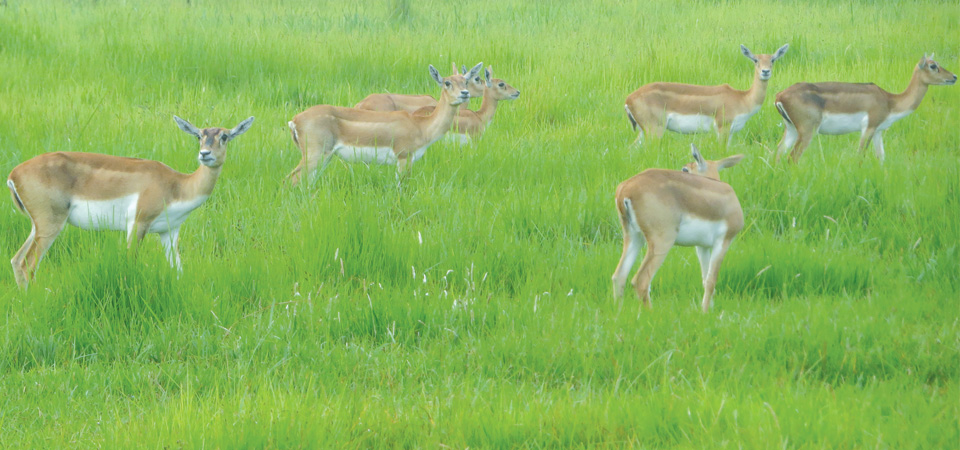Blackbucks thrive after relocation to Shuklaphanta

By Laxman Datta Panta
Mahendranagar, Oct. 27: Blackbuck antelope, known as Krishnasaar in Nepali, which had disappeared from Shuklaphanta National Park a few years ago, has started growing after relocation.
A decade after the relocation, the number of Krishnasaar has quadrupled. They were relocated to Hirapur Phanta in Shuklaphanta after seeing the possibility of their favourable habitat in the Kanchanpur district.
Now the number of Krishnasaar has reached 150. Since the transfer, their number has grown fourfold. Currently, there are 64 females, 48 males and 38 babies.
Chief of the office of the National Trust for Nature Conservation (NTNC), Shuklaphanta, Laxmiraj Joshi said that the increase in the number of Krishnasaars was encouraging. From 2012 to 2015, 42 Krishnasaars were relocated to the area.
Joshi said that the Krishnasaars’ death rate was high at the beginning. At present, the mortality is under control with regular medical treatment, he added. The NTNC has deployed two staff members to look after the animals in the area.
Joshi claimed that Shuklaphanta is a suitable habitat for the Krishnasaar and that the continuous increase in their number confirms this fact.
“Besides, we have been supplying water from tube-wells by constructing artificial lakes so that there is no shortage of water,” he said.
The Krishnasaars, which are now enclosed by an iron fence, have been integrated into the habitat and there is a possibility for them to be released into the open space after some time.
He said that the Krishnasaars could be shifted elsewhere if the department so decided. They have been shifted to Shuklaphanta from Nepalgunj and Lalitpur’s Central Zoo in August 2012 and from Khairpur of Bardiya in 2015. They have been relocated in two phases – 28 in the first phase and 14 in the second. Currently, 58.8 hectares of Krishnasaar habitat have been fenced. Earlier, relocation started on 17 hectares. The animals have been relocated to a suitable habitat aiming to increase the number of the endangered species.
A lake and a shed house (shade) have been constructed for the protection of the animals at Hirapur Phanta, about four kilometres north of the Arjuni Post and the highway.
Along with the habitat, a gravel road and scaffolding have been constructed up to Hirapur Phanta for easy movement of tourists. Staff quarters have been built and solar connections made in the area. Krishnasaars were relocated with the financial and technical support of NTNC. The animal is the second wild animal to be relocated to Shuklaphanta. Earlier, four one-horned rhinos were transferred from Chitwan National Park in 1991.
Khairapur has the highest number of Krishnasaars in Nepal. The animal, which is listed as protected wildlife under the National Parks and Wildlife Conservation Act, number about 300 in Khairapur. Krishnasaar of the antelope species was earlier found only in the Mrighasthali of Kathmandu along with Nepalgunj, Central Zoo in Lalitpur and Khairapur. Adult Krishnasaar, which likes to graze and live in the open, has black males and grey females. It breeds like deer in six months.
Recent News

Do not make expressions casting dout on election: EC
14 Apr, 2022
CM Bhatta says may New Year 2079 BS inspire positive thinking
14 Apr, 2022
Three new cases, 44 recoveries in 24 hours
14 Apr, 2022
689 climbers of 84 teams so far acquire permits for climbing various peaks this spring season
14 Apr, 2022
How the rising cost of living crisis is impacting Nepal
14 Apr, 2022
US military confirms an interstellar meteor collided with Earth
14 Apr, 2022
Valneva Covid vaccine approved for use in UK
14 Apr, 2022
Chair Prachanda highlights need of unity among Maoist, Communist forces
14 Apr, 2022
Ranbir Kapoor and Alia Bhatt: Bollywood toasts star couple on wedding
14 Apr, 2022
President Bhandari confers decorations (Photo Feature)
14 Apr, 2022











